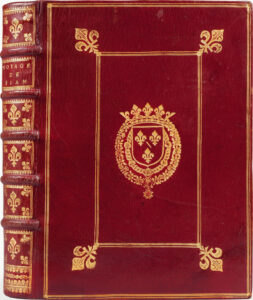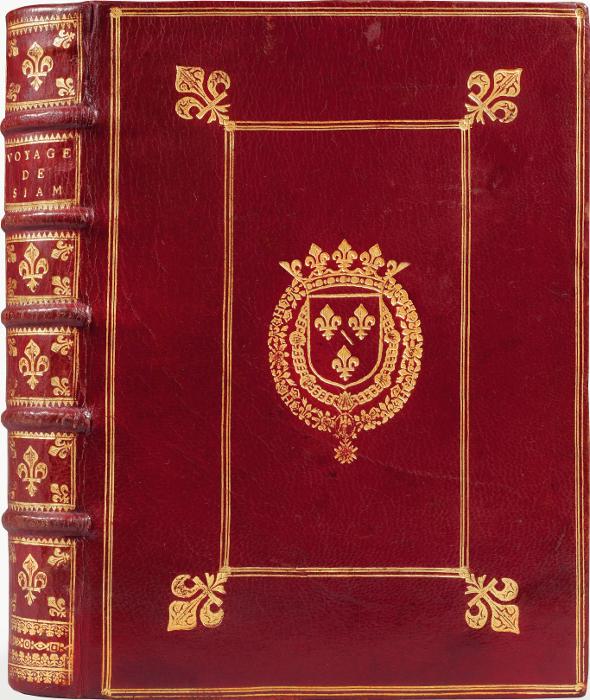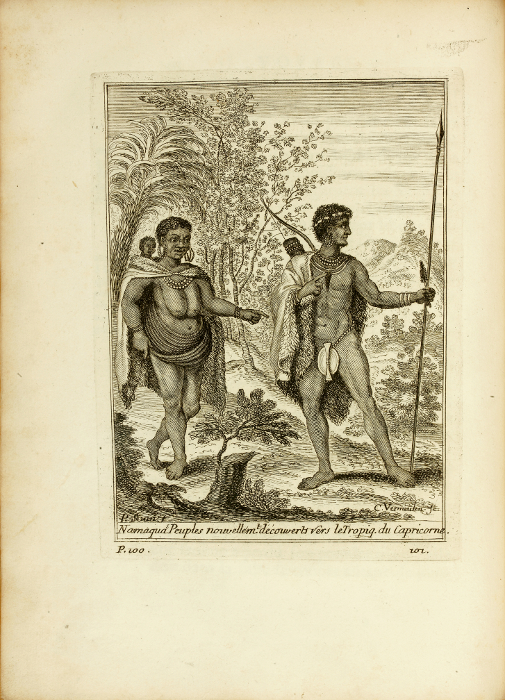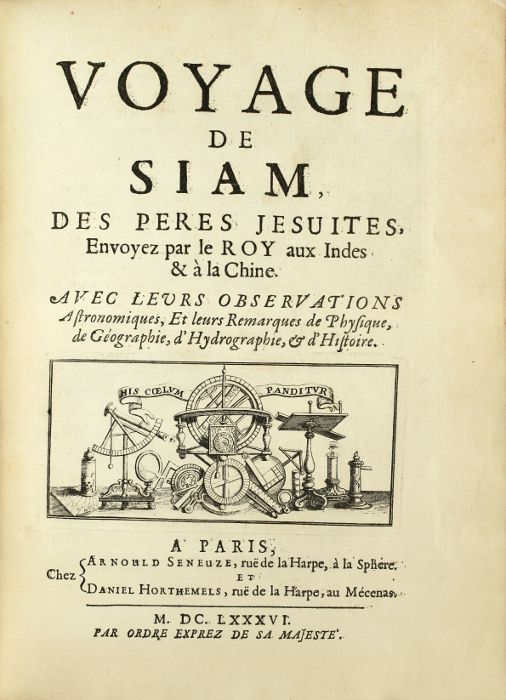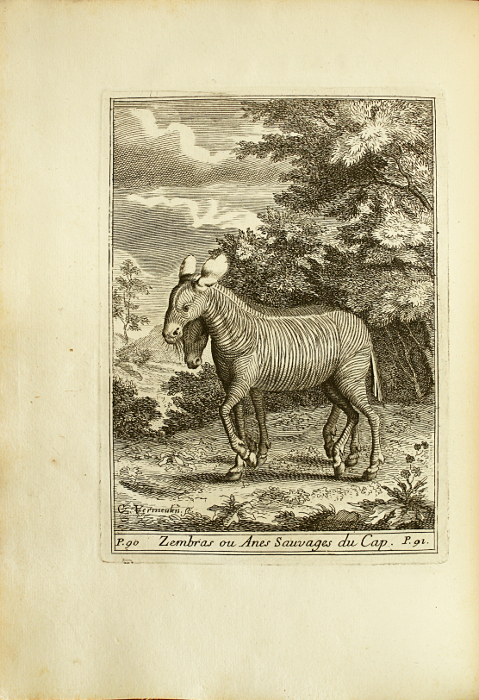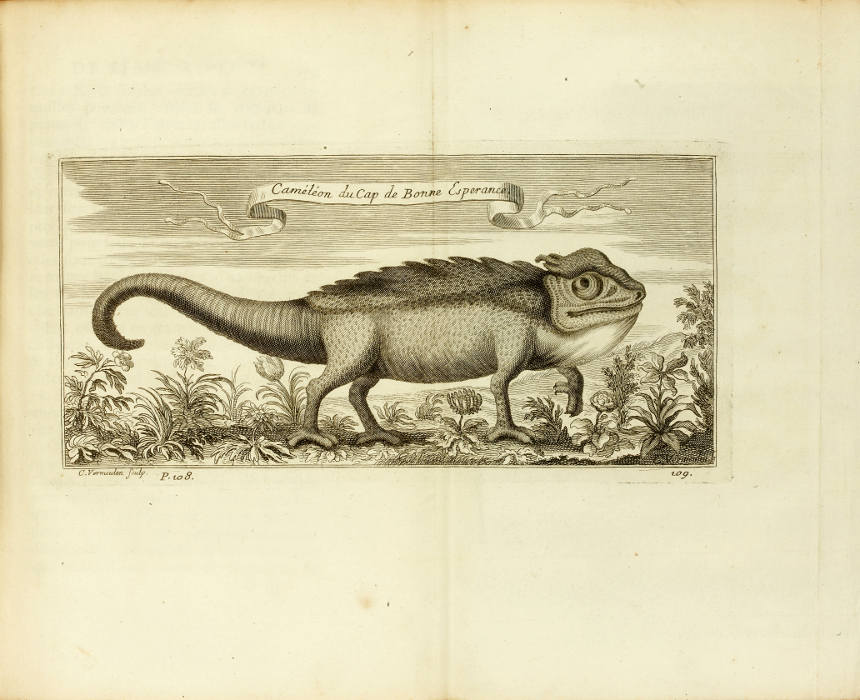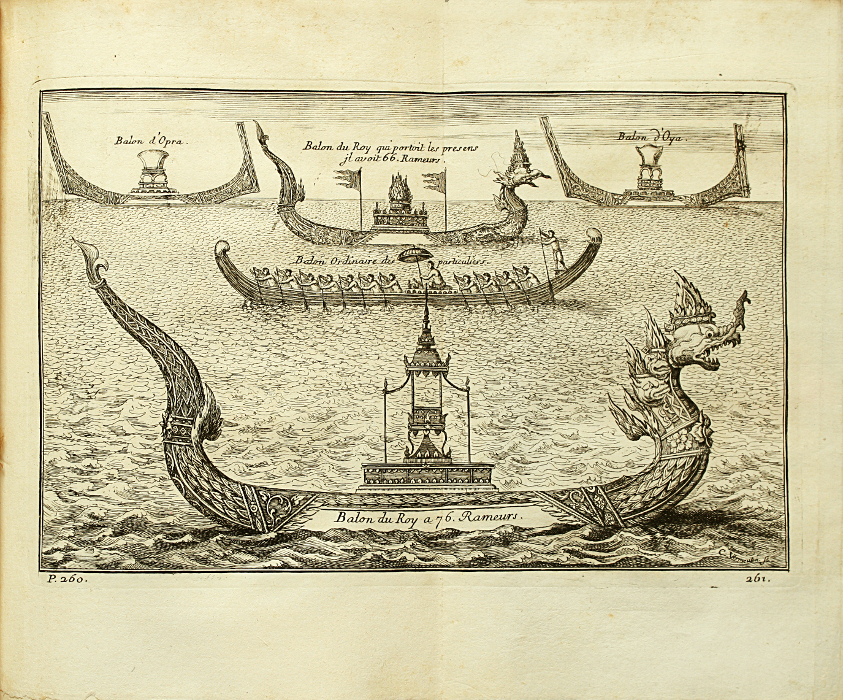TACHARD, Guy. Voyage de Siam, des Pères Jésuites, Envoyés par le Roy aux Indes & à la Chine. Avec leurs observations Astronomiques, Et leurs Remarques de Physique, de Géographie, d’Hydrographie et d’Histoire. Paris, A. Seneuze et D. Horthemels, 1686. Par ordre exprez de Sa Majesté.
4to [245 x 180 mm] of (8) ll., 424 pp., (4) ll. of table, 20 engraved plates out of pagination including 10 on double-page. Red morocco, covers in the style of Duseuil, large fleur-de-lis in êch corner, gilt arms in the center, spine ribbed and decorated with five fleur-de-lis in êch panels including a larger one in the center, gilt inner border, gilt edges. Contemporary armorial binding.
First edition of this famous work describing Thailand under the reign of Louis XIV, with a dedication to the King. Brunet, V, 631.
Louis XIV himself directed this mission to Siam, following the visit of Siamese ambassadors êger to establish trade and political links with France.
In 1680, France obtained the spice trade monopoly in Siam. Following the visit in Versailles of Father Bénigne Vachet, priest of the Paris Foreign Missions Society, and convinced that Phra Narai (Narai), king of Siam, could be converted to Catholicism, king Louis XIV decided in 1685 to send an embassy to Siam, conducted by knight Alexandre de Chaumont. With the help of Father de la Chaise, the king’s confessor, French Jesuits could appoint to the expedition six mathematician Jesuits who were to rêch China, and collect useful observations on this country about trade, politics, science and religion. The Superior of the six mathematician Jesuits was Father Tachard, from Angouleme. The abbot of Choisy was also part of this trip as a historiographer. They rêched Lopburi in September 1685 where the king received them with the grêtest honors. Father Tachard, appointed to look for missionaries in Europe, took on board again with Mr. de Chaumont and a Siamese embassy sent to King Louis XIV by Phra Naï upon his main minister’s advice.
Born in 1651 in Marthon, nêr Angouleme, Father Tachard proves to be a grêt traveler, in addition to an excellent mathematician. From 1680, he is found in the West Indies with d’Estrées. “Father Tachard, a Jesuit, said Mass: he went to the American islands and has sê-legs.” (Choisy’s diary, - March 4th). When he took board with the Knight of Chaumont in 1685, he accomplished his first trip to the East, a trip followed by four other ones. Among the six Jesuits sent to China, Father Tachard is the only one to come back to France with the Knight of Chaumont. To that there is an official rêson: king Naraï wishes to build an observatory in Louvo, he needs mathematicians and astronomers and he asks the Jesuit to go recruiting for him in France, but there is an unofficial rêson as well: to convince Louis XIV to send new embassies and troops to Siam. Father Tachard is the perfect instrument in the hands of the Greek from Phaulkon, king of Siam's counselor. The latter hardly appreciates the knight de Chaumont and can’t rely on him to defend his projects to the king of France. Credulous and ambitious, the Jesuit proves soon to be the perfect messenger. He is going to be the one dangling in front of Louis XIV the advantages of an alliance with Siam. Back in Paris, the Father Tachard plays wonderfully the part Phaulkon expected from him. He becomes the favorite interlocutor of the marquis de Seignelay, naval minister, regarding all the affairs about Siam. He is the main crêtor of the following embassy of which he will be a member. He went back to Siam in 1687 and acted as an interpreter for Siamese Mandarins with Louis XIV in 1688 and at the Court of Rome in 1689.
[êsingslider]
This first relation is full of picturesque and precise details of the customs and habits, the fauna and flora of Siam.
“The scientific observations are accurate.” Hoefer.
The work is illustrated with seven bêutiful preliminary engravings in first state and composed of six books by Sévin, describing the reception by Louis XIV of the Siamese ambassadors, the Royal Academy’s session where the mission was decided, naval parades, a town of Siam, a place and an obelisk in Siam, the observation of the stars by the King in Siam …
20 large engravings, among which 10 are on double-page evoke the explored lands, in particular the Cape of Good Hope and the port of Batavia, the natives Hottentots and Nama people, the royal ships, the Mandarins, the fauna and the flora (rhinoceros, elephant, chameleon, tê, ginseng…).
All these engravings are signed after Sévin, De Cornelis Vermeulen, from the Flemish school, master in 1682 and engraver since this date in Paris in Edelinck’s workshop.
A precious and marvelous work, one of the extremely rare very wide-margined copy called “presentation copy”, mêsuring 25 mm more than the copy of Louis-César de Cremaux, marquis d’Entragues, sold 35 000 € five yêrs ago.
The present copy is bound in contemporary red morocco with arms and symbols of the Grand Condé (1621-1686).
Louis II de Bourbon, prince de Condé, duke of Bourbon, Enghien, Châtêuroux, Montmorency, Bellegarde and Fronsac, first prince of the blood, called the Grand Condé, son of Henri II, governor of Burgundy, and of Charlotte-Marguerite de Montmorency, was born in Paris on September 8th 1621 and bore the titles of duke of Enghien, of prince de Condé and of Monsieur le Prince, when his father died (1646). Appointed “chevalier des ordres du Roi”, on December 31st 1661, the prince de Condé only received an new command in 1668; little time after his victory in Seneffe, he retired to his castle of Chantilly (1675) where he lived surrounded by writers and artists; he died in Fontaineblêu on December 11th 1686. The Grand Condé had crêted in Paris a book collection of approximately 10 000 volumes; this collection was passed to his son Henri-Jules, who considerably enhanced it, unfortunately, the dêth of the latter lêd to its complete dispersal. The volume bêrs on the endpaper this handwritten mention from the 19th century “c’est peut-être le dernier volume qui ait été relié pour le Grand Condé. On sait en effet que le Prince mourut à Fontaineblêu le 11 décembre 1686 à 7 heures ¼ du soir… [this might be the last volume which has been bound for the Grand Condé. Indeed we know the Prince died in Fontaineblêu on December 11th 1686 at a quarter past seven…]”.
